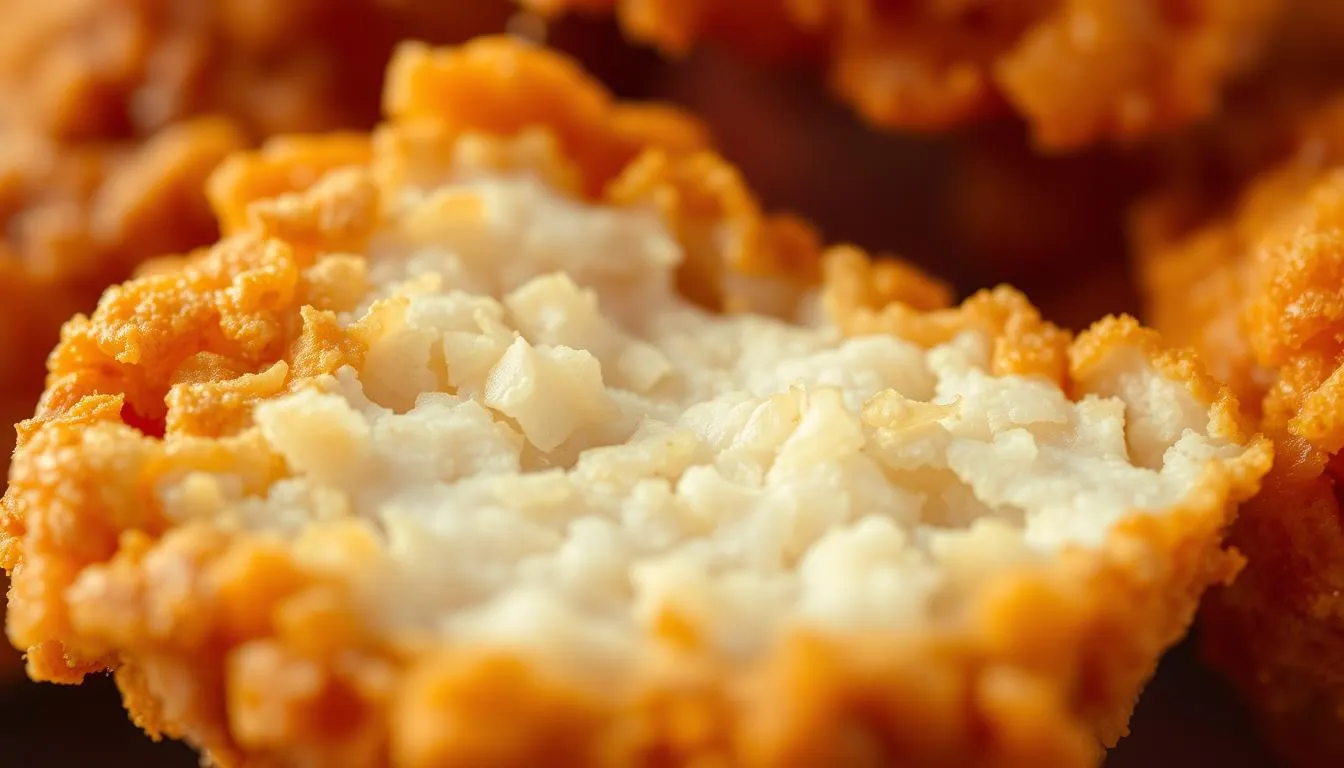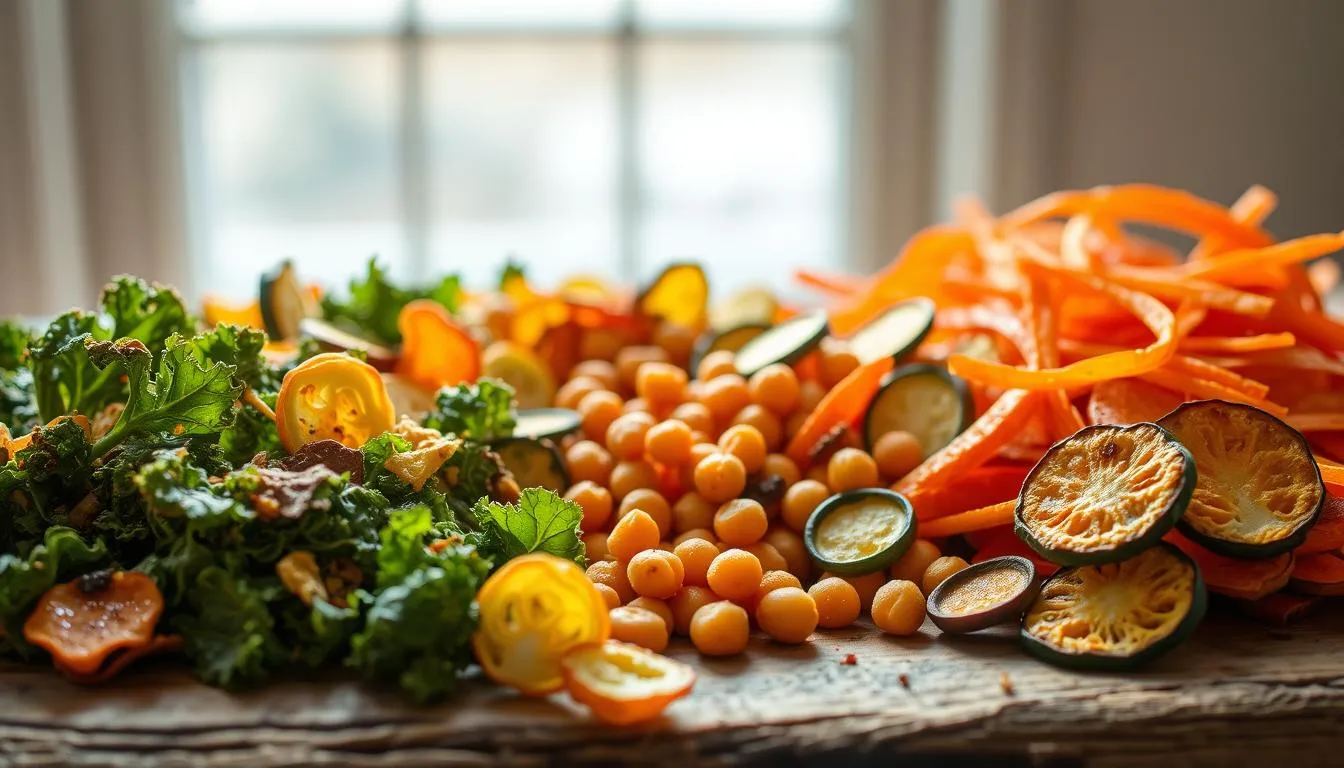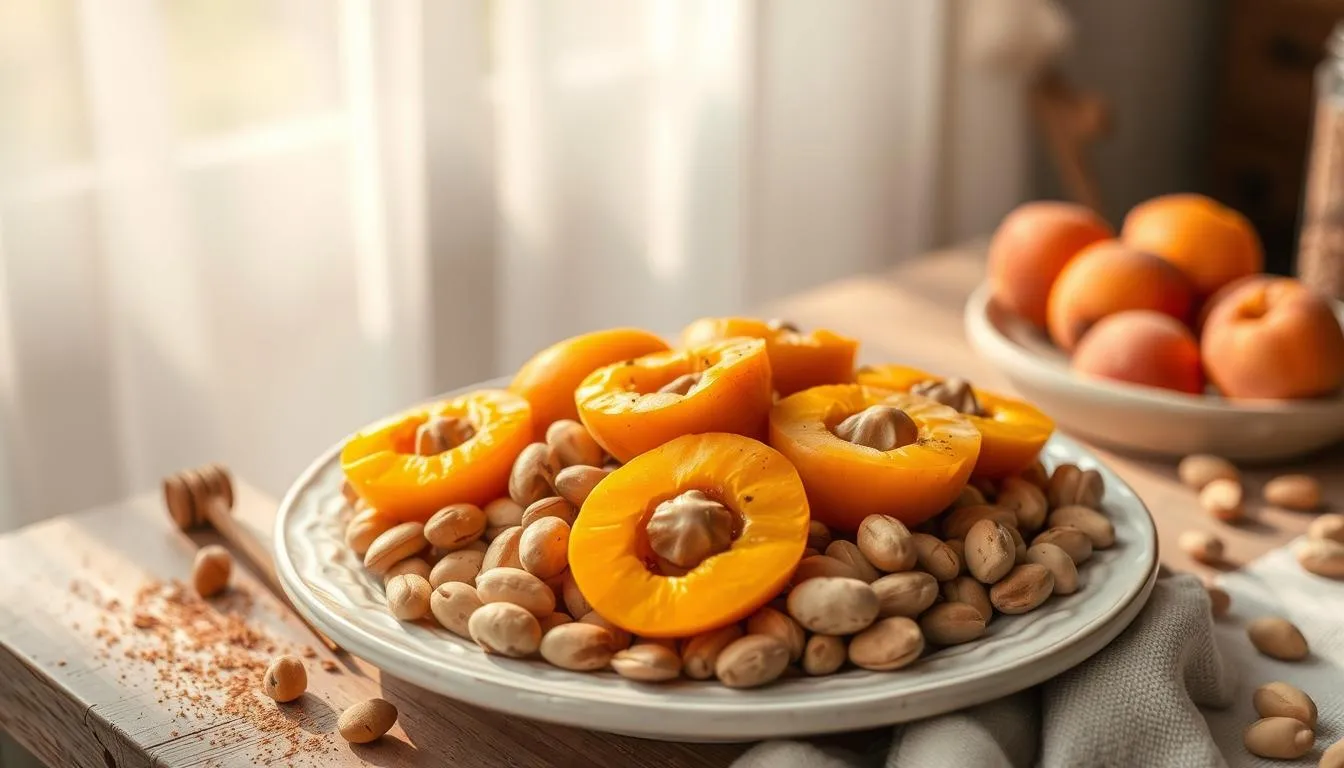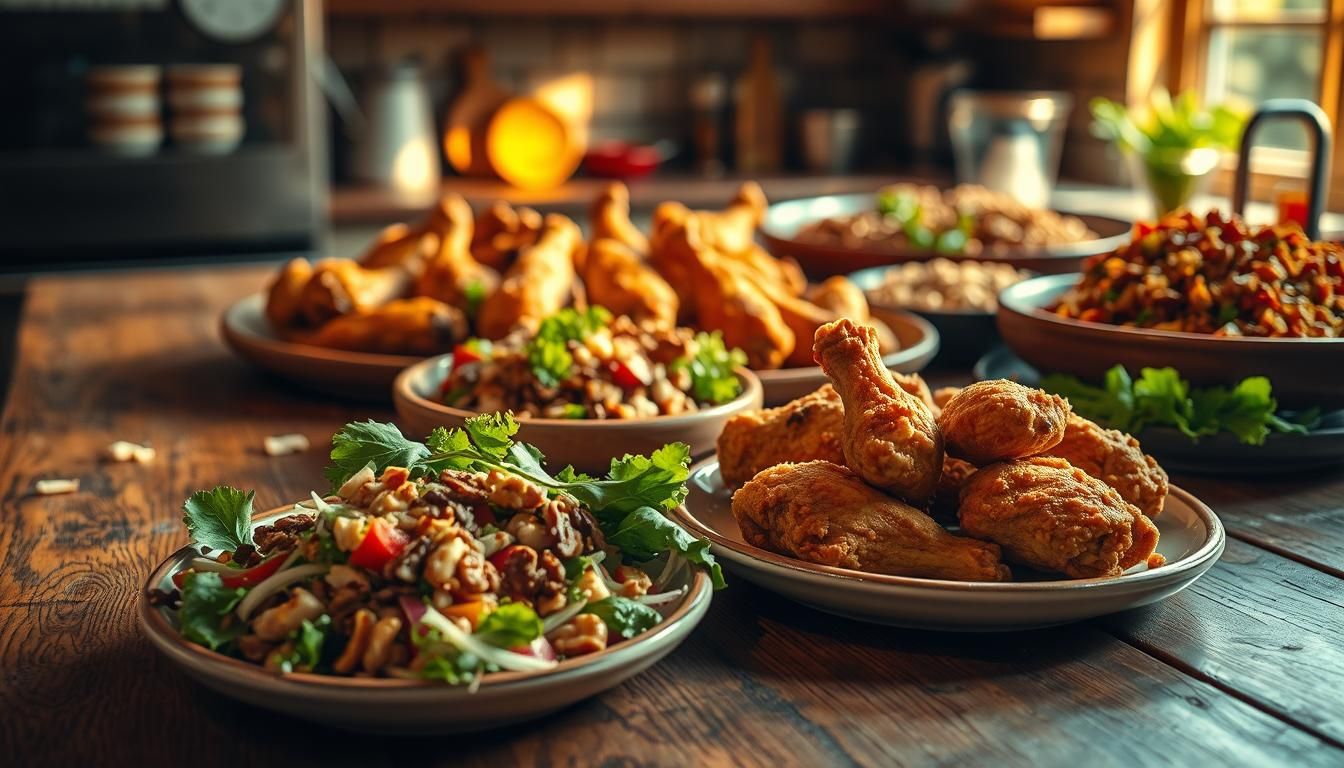I still remember the first time a roasted carrot chip snapped under my teeth. It was a small, ordinary moment that became a joyful memory. That sharp, golden bite made the whole meal feel special.
The “crunch factor” is that craveable crispiness that lifts texture and flavor and turns simple food into an experience. Whether you bake, roast, air-fry, or fry, reducing surface moisture creates that satisfying, audible snap.
In this guide youll find a wide variety of ideas from seasoned cauliflower “wings” to thin carrot chips and dried kale plus tips on cut size, heat, and timing. We blend science-backed basics with easy methods so you can reach the perfect level of crisp at home.
Expect practical notes on seasonings, coatings, oils, and storage. For deeper technique notes, see this helpful how-to guide on making foods crisp at home: how to make anything crunchy.
Quick aside: Sarah Lees snack roundup inspired a few tested ideas, and this piece has already reached 2025 views in early notes, showing how hungry readers are for simple, crunchy wins.
Key Takeaways
- Crunch boosts flavor and makes each bite more memorable.
- Baking, roasting, and air-frying remove surface moisture for a crisp finish.
- Cut size, heat, and timing are key to consistent texture.
- Seasonings, coatings, and oil build an audible snap without heaviness.
- Try veggie swaps and cornmeal crusts for regional, crackly options.
- Store and reheat smart to keep that just-made crunch for leftovers.
What Is the Crunch Factor? The Science Behind Crispy Texture
Golden browning and surface drying are the twin processes that turn soft produce into a crisp, memorable bite.
The Maillard reaction is a chemical dance between amino acids and reducing sugars that creates new aroma and flavor compounds. That browning also firms the surface, producing a distinct, crispy texture on the exterior of roasted, baked, or fried foods.
Moisture is the enemy of crispness. Evaporating surface water lets coatings and starches tighten into a brittle shell. Manage wetness by patting items dry, salting early to draw out water, and finishing on high heat to evaporate remaining surface moisture.

How cooking methods compare
- Frying: near-instant crust and deep browning.
- Roasting/Baking: steady dehydration for even crisp.
- Air-frying: fast convection that mimics frying with less oil.
Pick the right oilolive or avocado oil improves heat transfer and helps spices adhere. Try smoked paprika, garlic powder, or nutritional yeast to add savory depth without extra fat.
Coatings and doneness cues
Coatings like cornmeal, panko, almond flour, and nutritional yeast enhance flavor texture, color, and structure. A satisfying texture balances a tender interior with a well-browned shell; high heat alone wont guarantee that harmony.
Simple test: listen for a soft crackle and watch for evenly browned edges. When both appear, the process is complete. For deeper reading on sensory appeal, see the multisensory science behind snack appeal.
Crunch factor dishes: The Ultimate List of Crispy Veggie Winners
Turn everyday vegetables into craveable, crispy snacks with simple cuts and high heat.
Below are five easy winners, with quick how-tos and temps to get a consistent crispy exterior and bright flavor.

Cauliflower wings
Marinate florets in olive oil, garlic powder, and paprika. Bake at 425F for 2530 minutes, flipping halfway for an even crust. This is an excellent choice for game day with a spice-forward coating and a tender center.
Zucchini fries
Cut thin and coat in whole-wheat breadcrumbs or almond flour with herbs. Air-fry or bake to get a light crumb and golden texture without deep frying. Uniform cuts keep the coating airy and crisp.
Broccoli tots
Use fresh broccoli, pulse, mix with almond flour and a drizzle of olive oil. Form small tots and bake until brown at the edges for a fiber-rich, crunchy snack that still feels like comfort food.
- Carrot chips: slice 1/8-inch, bake at 400F, space evenly to drive off moisture for a satisfying crunch.
- Kale chips: wash and dry thoroughly, toss lightly in oil, season boldly, and bake until edges are shatter-crisp.
- Seasoning ideas: smoked paprika, garlic powder, or nutritional yeast to enhance flavor while keeping veg front and center.
| Veg | Cut/Prep | Temp | Key tip |
|---|---|---|---|
| Cauliflower | Florets, marinate | 425F, 2530 min | Flip halfway for even crust |
| Zucchini | Thin sticks, crumb coat | Air-fry 1012 min / Bake 2025 min | Uniform thin cuts for crisp |
| Broccoli | Pulsed tots, almond flour | 400F, 1822 min | Small size = faster browning |
| Carrot / Kale | 1/8” slices / dry leaves | 400F / 300325F | Even spacing; minimal oil |
Crispy Cornmeal Classics Across the United States
Across the U.S., cornmeal brings a satisfying snap and warm, toasty aroma to many regional favorites.
Southwestern cornbread sports diced jalapeos, chili powder, and cilantro for bold flavors. A high-heat bake creates a crackly crust that adds satisfying texture to each slice.
Southwestern cornbread: jalapeos, chili spice, and a crackly crust
Spicy additions and a coarse cornmeal top deliver a rustic bite. This is an excellent choice for chili nights or brunch.
Cornmeal-crusted fried fish: crunchy outside, flaky inside
A seasoned cornmeal mixture, the right oil temperature, and quick frying build a golden, crunchy exterior while the interior stays tender and flaky. Let rest briefly on a rack to keep the coating crisp.
Midwestern comfort: fried cornmeal mush, chicken tenders, and bacon-studded cornbread
Midwestern comfort food shines with fried cornmeal mushcrispy outside, creamy insideand cornmeal-crusted chicken tenders that please both kids and adults. Bacon-studded cornbread renders and toasts for extra texture and flavors.
- Try finishing grilled corn with a light cornmeal crust for a smoky-sweet cob that crackles on the bite.
- Cornmeal is a versatile ingredient that toasts beautifully; the Maillard reaction is the science behind its deep color and aroma.
- Storage tip: keep cornmeal in an airtight container in a cool, dry pantry to preserve freshness and performance.
“A well-seasoned cornmeal crust turns simple ingredients into beloved plates.”
Swap chiles, herbs, and spice blends to tailor heat levels and aromas across these regional riffs. Small tweaks in the mixture and oil at the pan make big differences in final texture and taste.
Apricot Meets Macadamia: Sweet Crunch Ideas from Breakfast to Dessert
When apricot meets macadamia, simple breakfasts and desserts gain an irresistible snap and depth of flavor.
 Toasted macadamia oatmeal is an excellent choice for a quick breakfast. Toast the nuts lightly in a teaspoon of oil to coax out aroma. Top creamy oats with chopped dried apricots and a drizzle of honey for bright, layered flavor.
Toasted macadamia oatmeal is an excellent choice for a quick breakfast. Toast the nuts lightly in a teaspoon of oil to coax out aroma. Top creamy oats with chopped dried apricots and a drizzle of honey for bright, layered flavor.
Toasted macadamia oatmeal with dried apricots and honey
This breakfast option balances soft oats with crunchy nuts and chewy fruit. The combo adds satisfying texture and steady energy for the morning.
Smoothie bowls topped with chopped macadamias, granola, and fresh fruit
Blend frozen apricot with macadamia nut butter and milk for body. Pile on chopped macadamias, granola, and fresh berries right before serving to protect crunch and contrast temperatures.
Apricot crisp and tart with macadamia nut toppings for next-level texture
For dessert, a macadamia-oat topping bakes into a golden crust that lifts the fruit. Or press chopped nuts into pastry for a nutty, crunchy base and finish with caramelized sugar for extra snap.
- Make on-the-go breakfast bars from oats, apricot, and macadamias for a portable option with fiber and protein.
- Toast nuts to intensify aroma and vary piece size for mixed bites.
- Add crunchy toppings just before serving to keep them crisp and elevate the eating experience.
Pro Tips to Level Up Crunch: Methods, Oils, Spices, and Storage
Small technique tweaks make the biggest difference to a truly crisp bite.
Pick the cooking route that fits your schedule and ingredients. Frying delivers fast, golden results and a quick seal. Roasting and baking remove surface moisture more slowly and give even browning. Air-frying boosts convection for quick crisping with less oil. Pan-frying is best for a fast, direct sear.
Bake, roast, air-fry, or pan-fry: choosing temps, timing, and the right oil
Use high-heat baking (400450F) for steady browning and roast at similar temps for caramelized edges. Air-fry at 375400F for faster results; pan-sear on medium-high for a golden exterior. Olive or avocado oil help heat transfer but pick one with a suitable smoke point for your method.
Seasoning and crust-building: herbs, spices, cornmeal, and nutritional yeast
Dust moisture-prone items with a light starch or fine cornmeal to form a rapid-setting shell. Layer smoked paprika, garlic powder, and nutritional yeast to add savory depth. Keep salt in check so the main ingredients shine.
Aftercare and storage: Batch on racks to cool so steam doesnt soften the exterior. Re-crisp leftovers in a hot oven or air fryer; avoid microwaving. Store dry goods like cornmeal in an airtight container to retain performance.
| Method | Temp / Time | Best oil | Key cue |
|---|---|---|---|
| Frying | 350375F / quick | Avocado oil | Golden, audible snap |
| Baking | 400450F / 2035 min | Light brush of olive oil | Even browning, dry surface |
| Air-frying | 375400F / 815 min | High-smoke oil spray | Fast color change, crisp edges |
| Pan-frying | Medium-high / 26 min per side | Avocado or refined oil | Quick sear, browned crust |
“Test a small option batch first to dial in seasoning, oil levels, and timing.”
Conclusion
A few simple movesdrying, high heat, and a light coatingare all you need to make everyday foods sing. Master moisture control and surface browning to get a consistent crisp on vegetables, cornmeal classics, and sweet bakes.
Balance matters: aim for a crisp crust and a tender interior, season to enhance flavor, and let the main ingredients shine. Start with approachable dishes like cauliflower “wings” (425F, 2530 min) or carrot chips (400F), then tweak cut size, heat, and timing to dial in the perfect texture.
Mix techniquesair-fry to finish, pan-sear to re-crispand store dry goods airtight. Try apricot and macadamia ideas for breakfast and celebrate regional comfort food like Southwestern cornbread or Midwestern fried cornmeal mush as excellent options. Keep experimenting so every bite delivers that satisfying crunch and aroma.
FAQ
What exactly is the crunch factor and how does it form?
The crunch factor refers to the pleasing crispy texture you get from foods with a dry, brittle exterior and tender interior. It forms through browning reactions like the Maillard reaction, moisture removal, and the right coating or crustthink thin oil layers, cornmeal, panko, or nut crumbscombined with high, even heat from baking, air-frying, or pan-frying.
How does the Maillard reaction impact flavor and texture?
The Maillard reaction creates complex savory and toasted notes while producing a firmer surface that enhances crispness. When proteins and sugars react at high temperatures, they brown and develop both aroma and a satisfying exterior that contrasts with softer insides.
Which cooking methods give the best crispy exterior?
Bake, roast, air-fry, or pan-fry depending on the ingredient. Air-frying and high-temperature oven roasting deliver dry, even heat that removes surface moisture fast. Pan-frying gives an instant, golden crust. Choosing the right oil with a high smoke pointlike avocado or refined canolahelps achieve consistent results.
How can I keep vegetables crispy, not soggy?
Dry them thoroughly before cooking, use a light coating (cornmeal, panko, or nut crumbs), and avoid overcrowding the pan or sheet tray. Preheat the oven or skillet and space pieces for airflow. For leafy greens like kale, remove excess moisture and use very low oil so they crisp rather than steam.
What coatings work best for a crunchy finish on plant-based foods?
Cornmeal, panko, ground macadamias or almonds, crushed crackers, and nutritional yeast all build great crusts. For gluten-free options, use crushed cornflakes or a mixture of cornmeal and gluten-free breadcrumbs. Season coatings with spices, salt, and a little starch or flour to improve adhesion and browning.
Can I get a crispy result without deep-frying?
Yes. Air-frying, high-heat roasting, and shallow pan-frying with a small amount of oil all produce excellent crispness. Techniques that remove surface moisture and expose the food to dry heat work best, so preheat equipment and finish under a broiler briefly when needed.
Which oils and temperatures are best for crisping foods?
Use oils with high smoke pointsavocado, refined canola, or peanut oilfor frying or high-heat roasting. Aim for 375425F for oven methods and follow air-fryer guidelines for your model. Adjust time based on size and thickness to avoid burning while maximizing a shatter-crisp exterior.
How do I store crunchy items to keep them crisp longer?
Cool completely, then place in an airtight container with a moisture absorber like a paper towel or silica packet. Store at room temperature for most crumb-coated snacks. Refrigeration can introduce moisture and soften textures unless the item is meant to be chilled.
Which vegetables produce the best crunchy snacks or sides?
Cauliflower wings, zucchini fries, broccoli tots, carrot chips, and baked kale chips all crisp up nicely with the right prep. Slice thin for fast baking, dry thoroughly, and use a light crust or oil spray to encourage a shatter-crisp bite.
How can I add sweet crunch to breakfast and desserts?
Toasted macadamia nuts, granola, and crisp oat or nut crumbles add texture to oatmeal, smoothie bowls, and fruit crisps. Combine nuts with a light honey or maple glaze and toast until golden to deepen flavor and create a crunchy topping that pairs well with fresh fruit like apricots.
Are there regional crispy classics I should try making at home?
Yes. Examples include Southwestern cornbread with a crackly crust, cornmeal-crusted fried fish, and Midwestern fried cornmeal mush or chicken tenders. These dishes rely on cornmeal or coarse crumbs for a distinct, satisfying crunch.
How do spices and seasoning affect the crisping process?
Spices and herbs add flavor to coatings but can influence moisture and browning. Use dry spice blends mixed into the crust or dredge, and avoid wet marinades immediately before coating. Salt after frying when necessary to preserve surface crispness and prevent drawing out moisture.
Can nuts like macadamias be used as breadcrumbs for a crunchy crust?
Absolutely. Finely chopped or pulsed macadamias make a rich, crunchy crust that toasts quickly. Mix with cornmeal or panko for structure and season well. Nuts add flavor, healthy fats, and an upscale texture for both savory and sweet applications.
What common mistakes make foods lose their crispness?
Overcrowding the pan, not drying ingredients, using too much wet batter, and storing warm items before sealing all cause sogginess. Also avoid low oven temps that steam instead of brown; higher, dry heat is usually the solution.
How can I replicate restaurant-level crunch at home?
Use a multi-step approach: pat ingredients dry, dust with starch or flour, dip in egg or a binder, then coat with a crisping mix like panko/cornmeal/nuts. Preheat your oven or skillet, avoid crowding, and finish with a quick blast of high heat or broil for the last minute to sharpen the texture.
